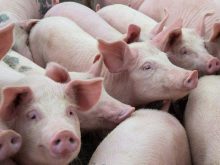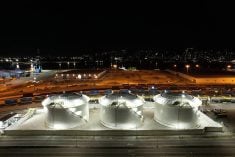TORONTO – Working the Royal Agricultural Winter Fair is more than a job for most.
For Dominic Rodriguez, who works as a janitor at the event, the annual event reminds him of his grandparents’ farm in Portugal.
“It’s a nice show. I like it the best. I can smell the cows and I can smell the horses.”
Rodriguez, a resident of Toronto’s Little Portugal district, has worked the Royal for the past 40 years but claims a poor understanding of English. He called up the union steward of the cleaning department to speak further.
Read Also

Quebec pork company calls for transparency around gene-edited pigs
Quebec-based pork company duBreton is calling for transparency around meats from gene-edited pigs on concerns that a lack of mandatory labelling will confuse consumers, and dilute certification claims. The organic sector is also calling for labelling rules.
David Turecky says he’s in a minority on the crew with his Polish ancestry.
“When I first started here, that was 21 years ago, it was pretty well all Portuguese gentlemen working on the night shift here.”
That’s when most of the heavy cleaning takes place. During the day, it’s more a matter of monitoring the washrooms, sweeping traffic areas and clearing away big messes.
Turecky enjoys the show, which was held Nov. 5-14, and says the rural-heavy crowds tend to be “less snooty” and complain less than people at some of the other events held at the Canadian National Exhibition site.
That’s ample compensation for the dirty work. It’s takes about a month after the show for the livestock areas to be scrubbed and disinfected.
While the cleaning staff is working inside, Harold Porter has nine days of work behind the cattle barns loading steaming manure with a truck-mounted crane.
A couple of semi-loads are hauled away every day.
“I take it to a guy who does cash crops. It all goes back into the land. It grows something the next year … a mushroom grower takes the horse manure,” Porter says.
Back inside, Lynn Platt drives from Cambridge, Ont., every morning, about 100 kilometres away, to greet visitors who start arriving at 7 a.m.
“I’ve been a ticket-taker for 14 years at the same door. You can’t do much better than that. It’s an awesome place.”
Hugh George also drives in from outside Toronto. He’s stationed at the head of a fenced lane leading from the cattle barn to the Royal’s main show ring for cattle.
“You have to make sure to keep (the public) away when the cattle are on the move. The farmers don’t want them touched and people tend to want to pet them…. It’s mainly the people you have to watch out for because they don’t know any better,” George says.
There are also unpaid volunteers working at The Royal, mainly farmers like Carolyn and Ron Harkness. Together with Ontario agriculture ministry employee Doug Richards, the couple was helping sort fact from fiction as hundreds of visitors dropped by Ontario Pork’s Pig Mobile display.
“I like talking to people and trying to inform them about what goes on at the farm and I let them know they should eat Ontario pork, Ontario beef … Ontario anything,” Ron Harkness says.
Placing a hand over his heart, Harkness explains that he and his wife are farming more for the love of it in recent years than for the money, since there have been few profits of late.
But the couple continues to farm and has a few chuckles when they’re at the Royal.
Some of the children, looking at the hindquarters of piglets, need to be informed that some are girls and some are boys. Others are discouraged from taking a piglet home as a pet.
Richards is occasionally asked about animal welfare issues, such as the crates for sows. He says he’s usually able to open the eyes of critics when he explains the reason they’re needed and describes the lengths that pork producers go through to keep their animals comfortable.
















